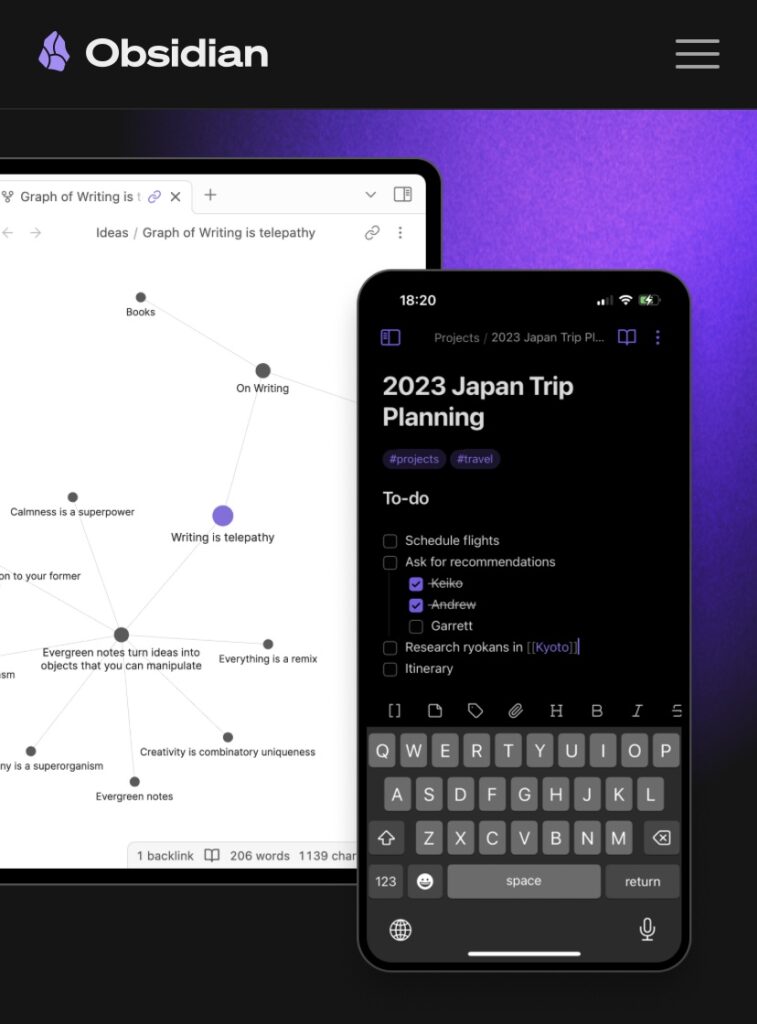
Over the last decade, personal note taking apps have exploded. Virtually every operating system comes with a default note taking solution. Microsoft has OneNote, apple has Notes, Android has a notes app. There are cross platform solutions as well such as Notion, DayOne Evernote, Roam, and Obsidian.
Today, obtaining information is as easy as opening an app, entering a search term and skimming whatever article you found. Organizing what you know is a skill many never develop but it’s something that software excels at. There have been many different attempts at landing on a solution for organizing human knowledge but one that sticks out to me is Wikipedia. It just works for organizing the world into articles with text, photos, and links.
What makes Obsidian so ideal for me is that it works across every system I use. It syncs using their proprietary end to end encrypted syncing solution called “Obsidian Sync” or icloud.
You can also store your vault (where your notes live), locally on your device (no syncing necessary). The files are saved using the standard .md (markdown) extension. What that means is that even if obsidian disappeared tomorrow your notes could still be opened as standard text files using wordpad or any other ultra basic text editor.
Obsidian uses Markdown which is a very simple text formatting system that’s easy to learn, and even if you choose not to learn how to it, you can use hotkeys and menus to control the look of your notes.
The killer feature of Obsidian is the ability to link notes together just like in Wikipedia. For example you might want a note about your favorite show and then to link that note to a note about your favorite actor in the show that lists other shows they’ve been in. This allows you to create a mind map of everything you know. There is even a graph view so you can see how all notes link together.

Obsidian also allows you to use Plugins to customize your experience. There are extensive videos reviewing the gamut of available options. Some allow you to generate reports and create databases if you’re so inclined.
One of my favorites is “Templater” which helps make generating the same note many times. I actually use this to record weird events in my neighborhood like suspicious vehicles or people, or to record vehicle maintenance, news events, or workouts.
Syncing Manually
I use android and ios devices, since I don’t pay Obsidian for the syncing feature, I create a new vault on each device and use the “PARA” file system created by Tiago Forte. My icloud vault is the master vault. I simply copy this vault and all of it’s contents to a micro sd card and then pop it into my new device. This copy on each device is for reference only, I don’t add new notes to that vault, instead if I must create a new note, I put it locally into it’s own vault. Since the file structures are the same, any new file can easily be sorted correctly at a later date.
How To Use It
Once you get familiar with linking to notes, you can start building your knowledge base. You can use it to track notes about the people, places, and projects in your life. I have a file I use to keep track of critters I find in my garden and I’ve been able to learn quite a bit about the ecology of my yard. The weird stink bug looking things? Those are leaf foot bugs. The hornets under my eves? Not hornets at all, they’re wasps!
Another way I use it is for keeping track of complex processes I’ve followed. For example I set up a virtual private server, installed nginx proxy manager, and bitwarden and while I don’t remember how I did it, I have a link to the video and a description of the process in the note which can remind me.
Maintenance on my vehicle, important conversations with my spouse, or reviews of menu items ordered from one specific restaurant can all be pulled up with a tap.
Any time I buy something expensive, I take a photo of it and create an entry and file it under “tools”. This is partly for insurance purposes but also to help me see what tools are available should I ever need a tool and can’t remember if I have something that will do the job.
Progress
I’m currently nearing 700 notes in my vault. I find myself using it regularly to look up or record information. It’s a free and powerful tool that can give you a leg up over the competition who don’t have a resource to use when they need to access highly specific information that is useful to them. There are lots of videos on youtube that can teach you how to use it, and quite a bit about the PARA system from Tiago Forte and his company Forte Labs, I hope you’ll check it out.